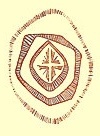A Catholic website for the modern reader

Holy Saturday
by
Fr. William Messenger
THE EASTER VIGIL
THE celebration of the Year!!!
On Holy Saturday, the Church waits at the Lord's tomb. Through our reflections on Holy Thursday and Good Friday, we have already seen that these three days comprise one celebration called TRIDUUM. Easter has no significance outside of the experience of Thursday and Friday. Therefore, only after the solemn vigil during the hours of darkness does the Easter celebration begin with a spirit of joy.
The vigil is divided into four parts:
a) SERVICE OF LIGHT
b) LITURGY OF THE WORD
c) LITURGY OF BAPTISM
d) LITURGY OF THE EUCHARIST
a) SERVICE OF LIGHT
In ancient times a vigil ceremony began in the middle of the night and lasted until dawn. For the Easter Vigil, the celebration of the Eucharist occurred at dawn, bringing to full reality the Resurrection. The night was spent in readings and prayers. The lamp was lit at the beginning using a ceremony borrowed from the Jews. The light was expanded to bonfire proportions in the Irish liturgy, and, along with much symbolism identifying the candle with Christ, came eventually into Roman practice. A solemn prayer of praise and blessing was sung, developing the theme of God's redeeming us out of darkness with the light. In our present liturgy, we celebrate Christ as the Light who pierces darkness and shows us the way to the Father. We conclude with a song praising God's power.
b) LITURGY OF THE WORD
The reading of the Word of God is the fundamental element of the Easter Vigil. The Hebrew Scripture readings retell our history: creation and re-creation by redemptive acts of God. This reliving of the history of the people of faith is retold and becomes the introduction of new members into the community. As the night goes on, the presence of Christ becomes more alive in the reading of the Christian Scriptures. Although in the ancient liturgy many readings and prayers were used over a period of several hours, we use at most only nine readings--seven from the Hebrew Scriptures and two from the Christian Scriptures--all highlighting God's activity in our lives.
c) LITURGY OF BAPTISM
The new members have been introduced into the community by hearing our history retold. We now acknowledge our early heritage, by calling on the heavenly members of the Church, in the Litany of the Saints. Water is blessed, while the many acts of God through water are recalled: the primordial waters of chaos before creation, purification of the human race through the flood waters, salvation through the Red Sea, etc. The sacramentality of matter (i.e. matter as a means of salvation), stands out here more than at any other place in the Church's Liturgy. The Profession of Faith by the Baptismal candidates, and by the congregation, brings us nearer to Christ. Union with him takes place through the three sacraments of initiation: Baptism, Confirmation and Eucharist. The candidates are now joined to the holy people of God.
d) LITURGY OF THE EUCHARIST
Through his Death and Resurrection, the Lord has prepared a table for his people. In the Eucharist, he calls his people to that table. We share in common the bread and wine--the Lord's Body and Blood. In this sharing, we are filled with new life and are drawn together in unity:
One loaf, one cup, one table, one death and
Resurrection.
One Lord, one faith, one Baptism, one God and
Father of all.
Easter is celebrated for fifty days, reaching its fullness in the pouring out of the Spirit upon God's people at Pentecost. These fifty days are the most solemn, festive days of the Church's year, and are meant to pre-figure the unending days of the eternal celebration of the Lord's triumph.
(Fr. William Messenger is a priest in the Archdiocese of Los Angeles)
